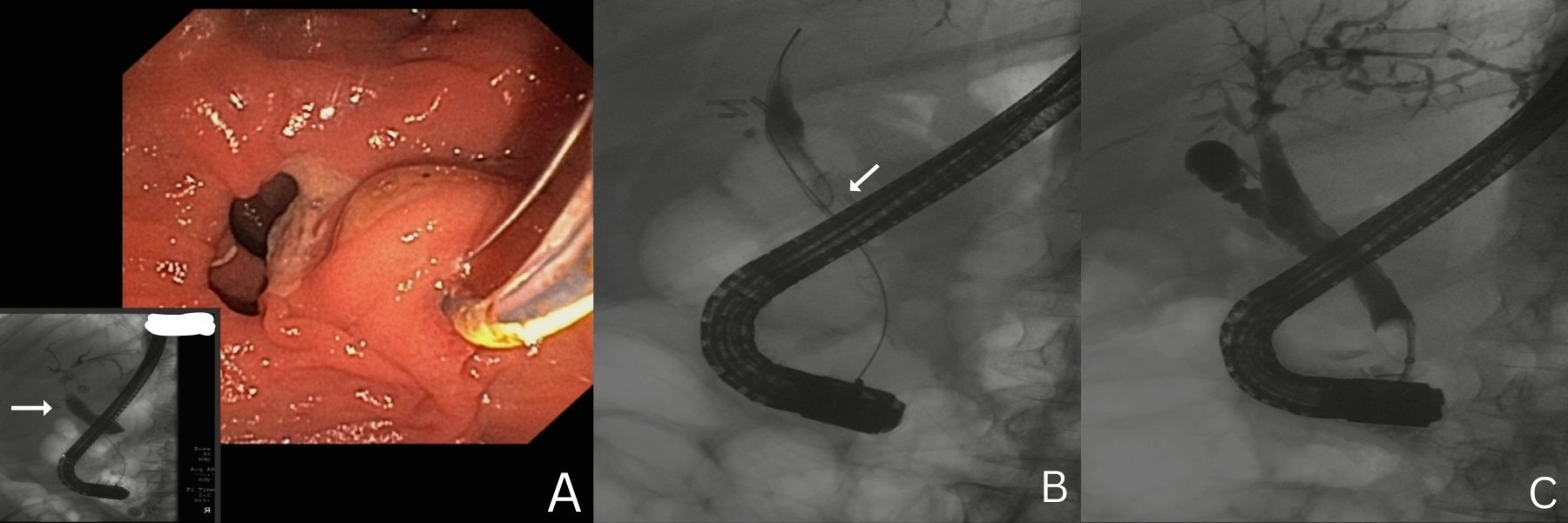Tuesday Poster Session
Category: Endoscopy Video Forum
P3222 - CRAP! Cholangioscopy as a Rescue for an Adherent Stone Post Cholecystectomy Formed Around a Migrated Surgical Clip Into the Common Bile Duct

Chukwunonso B. Ezeani, MBBS (he/him/his)
Baton Rouge General Hospital
Baton Rouge, LA
Presenting Author(s)
1Baton Rouge General Hospital, Baton Rouge, LA; 2Center for Advanced Endoscopy, Beth Israel Deaconess Medical Center, Harvard Medical School, Boston, MA; 3Christus Highland Hospital, Shreveport, LA; 4Beth Israel Deaconess Medical Center, Boston, MA; 5BIDMC, Boston, MA
Introduction:
Cholecystectomy is the gold standard therapy for symptomatic gallstones. A rare associated complication is the migration of surgical clips into the biliary tract where they act as a nidus for stone formation. Endoscopic Retrograde Cholangiopancreatography, (ERCP), the conventional treatment for common bile duct (CBD) stones, is effective in 80% of cases. Advanced endoscopic technique is favored for complex cases with high surgical risk, sometimes utilizing cholangioscopy. We present a case of an adherent stone around a migrated surgical clip successfully treated by cholangioscopy
Case Description/Methods:
An 88-year-old woman with a history of cholecystectomy 30 years ago presented with abdominal pain, nausea, and vomiting. Laboratory data revealed total bilirubin of 1.2 mmol/L and ALP 221 IU/L. Abdominal CT revealed intra and extrahepatic biliary ductal dilation, multiple CBD stones, largest 2.2 x 1.2 cm.
Initial ERCP revealed several large filling defects in CBD. Sphincterotomy and multiple balloon sweeps were performed with a 15 mm biliary balloon beginning at the bifurcation. Multiple stones and pus were removed successfully. A repeat cholangiogram revealed CBD measuring 20 mm and dilated intrahepatic ducts. A 2cm filling defect suggestive of stone was noted in CBD, encasing a metallic density probably a migrated surgical clip (A). A 10 Fr 5 cm double pigtail plastic biliary stent was placed for conservative management.
ERCP performed 4 weeks later revealed a persistent filling defect around a previously noted clip (B). We performed spy glass cholangioscopy and this large CBD stone was visualized. Electro-hydraulic lithotripsy for fragmentation of the stone was then performed successfully and multiple stone fragments were visualized. The biliary tree was then swept with a 15 mm balloon starting at the bifurcation of the biliary tree. Multiple stone fragments and sludge were removed successfully, and the clip was swept out successfully. Multiple balloon sweeps were performed. Excellent bile and contrast drainage was seen endoscopically and fluoroscopically. Final occlusion cholangiogram showed no evidence of filling defects in the CBD (C)
Discussion: Cholangioscopy-assisted lithotripsy is safe and effective for the removal of an adherent stone around a migrated surgical clip in the biliary tract that cannot be extracted using conventional techniques. Prospective studies are needed to evaluate its utility, feasibility, and cost-effectiveness in primary ERCP for difficult CBD stones

Disclosures:
Chukwunonso B. Ezeani, MBBS1, Samuel Igbinedion, MD2, Kwabena O. Asafo-Agyei, MD3, Erik Holzwanger, MD4, Sultan Mahmood, MD4, Mandeep Sawhney, MD, MS4, Tyler Berzin, MD, FACG4, Moamen Gabr, MD, MSc,4, Douglas Pleskow, MD, FACG5. P3222 - CRAP! Cholangioscopy as a Rescue for an Adherent Stone Post Cholecystectomy Formed Around a Migrated Surgical Clip Into the Common Bile Duct, ACG 2023 Annual Scientific Meeting Abstracts. Vancouver, BC, Canada: American College of Gastroenterology.
